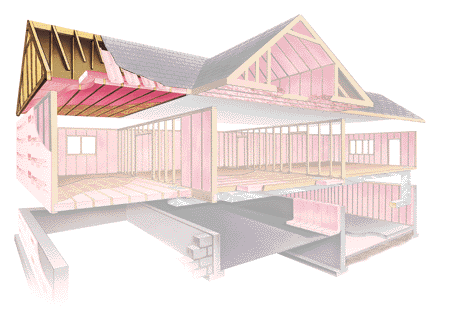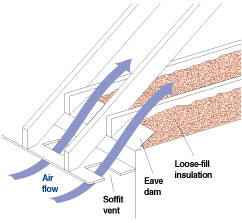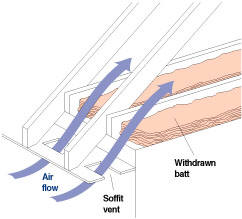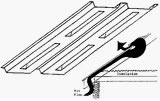Adding insulation to your attic, as shown in Figure 1, is one of the wisest home improvements that you can undertake. Insulation not only provides a return on the investment but makes your home much more comfortable for your family and reduces drafts and illness.

Figure 1 - Attic insulation
Before you add any insulation to your attic, you need to know how much insulation (R-value) is already there. This is simply done by measuring the thickness of your attic's existing insulation. Most older homes have between 3 and 6 inches of fiberglass blanket insulation. This is roughly equal to an R-value between R-9 and R-19.
Subtract the amount of your attic's existing insulation from your area's recommended R-value to determine how much more should be installed. R-25 insulation is great for adding a second layer to existing attic insulation.
Adding Attic Installation
First, some temporary flooring should be laid across the joists to provide some footing, and a temporary work light should be used to offer adequate lighting.

Figure 2 - Eave dam for use with loose fill insulation
Install the insulation at the outer edge of the attic space and work toward the center. This allows for more headroom in the center of the space, where cutting and fitting can be done. It's also a good idea not to get insulated into a corner
where it will be hard to get back to the attic entry way without walking on or crushing the freshly installed insulation.

Figure 3 - Insulation batt placed to allow air flow from soffit vents
If the joist cavities are completely filled, lay the new insulation in long runs perpendicular to the direction of the joists, and use leftover pieces for small spaces. If the cavity is not completely filled, use the appropriate thickness of insulation to fill it to the top, then add an additional layer of insulation in the perpendicular direction.
The insulation should extend far enough to cover the tops of the exterior walls, but should not block the flow of air from the eave vents, as shown in Figure 3.
To make sure the eave vents aren't blocked, an eave dam, as shown in Figure 2, or a rafter vent, as shown in Figure 4, should be installed to provide unrestricted air flow from the soffit to the attic.

Figure 4 - Rafter vent
Insulation should be kept three inches away from recessed lighting fixtures unless the fixture is marked I.C.
(Insulated Ceiling), which is designed for direct contact with the insulation. If insulation is placed over an unrated fixture, it may cause the fixture to overheat and perhaps start a fire.
Additional information on: Insulating around recessed lighting
As well, the insulation should always be installed at least three inches away from any metal chimneys, gas water heater flues or other heat-producing devices.
Around masonry chimneys or other areas that have small openings, stuff these spaces with small pieces of unfaced insulation, which will not burn.
